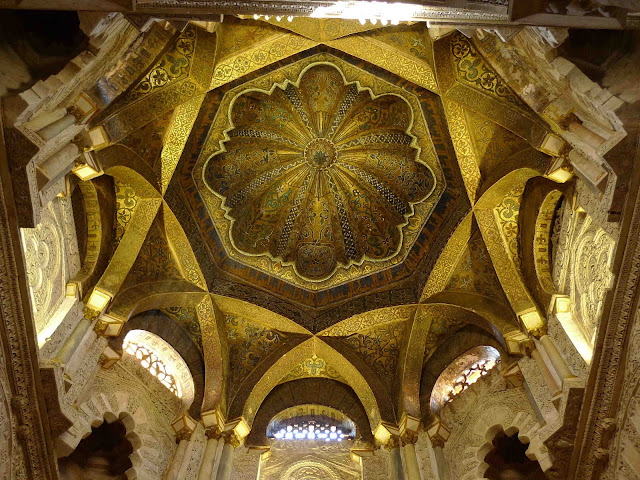The Patio de los Naranjos, The Mezquita, Cordoba, Spain
 |
| Pebble Mosaic and Irrigation channels |
One of the places I most wanted to revisit when I went to Spain this winter was the city of Cordoba in Andalusia. Cordoba’s most significant monument is the Mezquita, the Great Mosque and Cathedral. Construction began in 785 AD by the Emir Abd ar Rahman on the footprint of a Visigothic church. It was expanded in the 9th and 10th Centuries to become one of the largest and most beautiful mosques in the world, covering 14,000 square meters. 1000 years ago, Cordoba was the largest city in the World and a great center of culture and learning.
The design allowed for a feeling of airiness in the massive space. In the 16th Century a cathedral was built in the center of the mosque which reduced the number of columns from the original 1,293. Though the cathedral is beautiful in of itself, the mosque was just too magnificent to destroy and was preserved and adapted after the Christian conquest of Muslim Spain.
 |
| Columns and Double Arches in the Mezquita |
The most spectacular part of the Mezquita is the Mihrab (prayer niche) and dome, which is located in the qibla, the wall oriented in the direction of Mecca. The arches are more elaborate in this section and those over the Mihrab itself are embellished with stunning gilded mosaic cubes. These were gifted by the Emperor of Byzantium of Constantinople, which is present day Istanbul in Turkey. The mosaic decoration, though Islamic, has a strong Byzantine influence.
 |
| Mihrab |
 |
| Dome over the Royal Prayer enclosure |
First thing in the morning I headed across the street before the crowds of tourists arrived. There were morning strollers and birds in the trees, and the fountains were trickling softly. The courtyard was traditionally used as a place to do ablutions, which is traditional in a mosque. One washed before prayers. The courtyard was developed around the year 976, making it one of the oldest gardens still in existence on Earth.
The run off from the substantial roof of the mosque is collected in a cistern on top of which the patio is built. Water from the cistern comes up in to a rectangular pool with four columns at the corners with brass spigots. There is a central fountain as well that now has a whimsical waterwheel folly that sprays twirling arcs of water in all directions. The pool is located on the north side of the patio across from the wall of the mosque. Water from the pool flows in to a recessed brick lined channel that runs the length of the patio. Perpendicular channels run across the river pebble pavement to circles that surround each of the trees planted in a grid. Most of the trees are bitter oranges, but there are a few date palms and cypresses and an olive tree as well. A wooden block is used to control the flow of water in to each channel until the sufficient amount of water needed to irrigate each tree has been delivered. Excess water then returns to the cistern, minimizing waste. The flowing water working its way through the garden ties everything together in a beautifully functional way.
 |
| Brick lined irrigation channel |
The alignment of the grid of trees mirrors the alignment of the columns inside the mosque creating an ingenious spatial relationship between the two. Lines of stones in the pebble mosaic pavement also accentuate the grid pattern of the whole complex. There is a similar patio at the Cathedral in Sevilla that is a remnant of the Great Mosque that once occupied the site there that is paved with brick.
 |
| Patio de los Naranjos, Sevilla |
The irrigation pattern of a linear channel connecting circular water wells around the trees is mimicked in the fountains of Moorish palaces such as the Alhambra, and the Alcazars of Cordoba and Sevilla. These fountains are some of the most elegant ever conceived, and use water as a way to connect interior and exterior courtyard spaces. One of the reasons that these places are so enduringly beautiful is that they speak literally of the root of their inspiration. Irrigation allowed man to settle and raise food, which led to civilization. That gift in turn inspired architectural form and reflected the connection between water as the source of life and the ability of man to build and live in an urban environment. That connection is conveyed with brilliant clarity in the Mezquita at Cordoba.
 |
| Fountains and water channel, Patio de los Leones, The Alhambra, Granada |
I hope that I will be fortunate enough to incorporate more of those beautiful ideas in to my own work in the future. I am so ready to build something extraordinary. Let me know if you are interested.



Very enjoyable. Nice to get some of your excellent pictures tied together with historical and personal narrative. Thanks.
ReplyDeleteThis comment has been removed by a blog administrator.
ReplyDeleteThe top picture looks fantastic, my ideal kinda place
ReplyDeleteDriveways paving Essex
Great photos! I hope you had a great time doing your trips in Cordoba. Knowing about Cordoba's cultural background you will certainly find interesting additional aspects when visiting its great monuments - first of all of course the world-famous Mezquita, the Moorish mosque - and museums. Visit my site Simply Cordoba Thanks and God bless :)
ReplyDelete